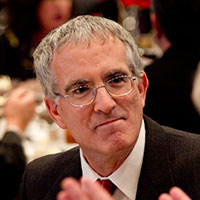“I think most people don’t appreciate the effect that economics has on their everyday lives. I want to do work that is useful, and that means work that has policy implications…I do like to generate work that can be used to guide decisions.”
– Jeffrey Humphreys, Director, Selig Center for Economic Growth
“Dr. Humphreys’ research has been invaluable for understanding and communicating the statewide impact of the port industry on jobs and productivity,” says Robert Morris, senior director of corporate communications at the Georgia Ports Authority. “He delivers a new report about every three years, which lets everyone from lawmakers to cargo owners track the success of our terminals and their benefits to our customers and the state of Georgia.”
After earning a doctorate in 1989, Humphreys accepted a job with Terry College’s Division of Research, which was renamed the Selig Center for Economic Growth within a year. In time, he became the center’s director and added to the scope of the center’s research and outreach.
Humphreys looked beyond the yearly state economic forecasts and impact reports that were staples of the center’s early work. He created a new study of the multicultural economy in 1991. It was a compendium of the buying power of racial and ethnic minorities in the United States, providing hard data to businesses and advertisers about the size, share and growth rate of underserved consumer markets.
“The Multicultural Economy Report came from a phone call I received. An African American businessman called me because he was trying to get financing to start a business and he was trying to get data on the buying power of African Americans in Georgia, and there were no data on that at the time,” Humphreys said. “There was Census data on the number of African Americans and their monthly income, but nothing that put it all together and gave him a buying power number.
“That sparked an idea that a lot of the data was already out there, but nobody had taken that data and put them together. The first study focused only on African Americans in Georgia, but I later expanded it to include all racial and ethnic minorities across the United States.”
Humphreys’ Multicultural Economy Report earned the Selig Center a national reputation. His work has been referenced by The New York Times, Forbes and The Wall Street Journal, among others.
Humphreys’ Multicultural Economy Report earned the Selig Center a national reputation. His work has been referenced by The New York Times, Forbes and The Wall Street Journal, among others. In marketing parlance, the Selig report owns the minority buying power category, with no competing sources emerging. Its longevity has become a strength, alerting businesses to emerging patterns and changes within key demographic markets in the U.S.
Inside the state’s borders, however, the Selig Center is better known for the annual Georgia Economic Outlook. Humphreys is the chief economist behind the popular luncheon series built around the college’s yearly forecast. With nine tour stops, the series travels throughout the state informing business and government leaders about the direction of next year’s state and national outlook.
Because of the regard he’s earned, Humphreys was named to the Council of Economic Advisors by former Georgia Gov. Sonny Perdue, a post he’s held continuously for 16 years. His expertise is also sought by a number of outside clients, from businesses like Gulfstream Aerospace and Georgia Power to nonprofit organizations such as the United Negro College Fund and the East Lake Foundation, which have hired the Selig Center to conduct studies.
“The mission of the Selig Center is to conduct applied economic and demographic research related to Georgia’s current and future growth,” Humphreys says. “I think that every study we do is important to some kind of policy decision, and I like that.”

About the Researcher
Jeffrey Humphreys
Director of the Selig Center for Economic Growth
Terry College of Business






